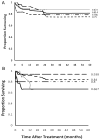Early vs. delayed diagnosis of severe combined immunodeficiency: a family perspective survey
- PMID: 21035402
- PMCID: PMC3022101
- DOI: 10.1016/j.clim.2010.09.010
Early vs. delayed diagnosis of severe combined immunodeficiency: a family perspective survey
Abstract
Infants affected with severe combined immunodeficiency (SCID) are susceptible to severe and recurrent infections and do not survive unless provided with immune reconstituting treatments. In the absence of population-based newborn screening, infants with SCID who do not have an affected older relative are ascertained only after they have developed infections. However, only limited data are available from the perspective of patients and families to indicate what proportion of SCID cases might benefit from earlier detection by pre-symptomatic screening, whether adequate treatment facilities are available, and how screening could improve SCID treatment outcomes. A survey of parents of children with SCID evaluated family history, pre- and post-diagnosis events, outcomes, and impact of SCID on families. Affected infants diagnosed with SCID as neonates had better survival, demonstrating the potential benefit of universal newborn screening.
Copyright © 2010 Elsevier Inc. All rights reserved.
Figures






References
-
- Buckley RH. Molecular defects in human severe combined immunodeficiency and approaches to immune reconstitution. Annu Rev Immunol. 2004;22:625–655. - PubMed
-
- Werther RL, Crawford NW, Boniface K, Kirkwood CD, Smart JM. Rotavirus vaccine induced diarrhea in a child with severe combined immune deficiency. J Allergy Clin Immunol. 2009;124:600. - PubMed
-
- Chan B, Wara D, Bastian J, Hershfield MS, Bohnsack J, Azen CG, Parkman R, Weinberg K, Kohn DB. Long-term efficacy of enzyme replacement therapy for adenosine deaminase (ADA)-deficient severe combined immunodeficiency (SCID) Clin Immunol. 2005;117:133–143. - PubMed
-
- Buckley RH, Schiff SE, Schiff RI, Markert L, Williams LW, Roberts JL, Myers LA, Ward FE. Hematopoietic stem-cell transplantation for the treatment of severe combined immunodeficiency. N Engl J Med. 1999;340:508–516. - PubMed
Publication types
MeSH terms
Grants and funding
LinkOut - more resources
Full Text Sources
Medical

